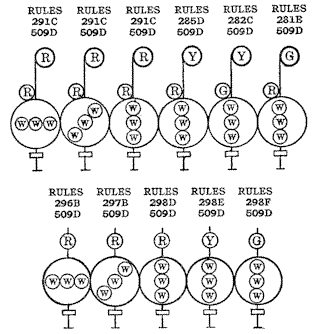Eastward. | |
175-2 | MX Siding |
169-2 | HF Crossover Roods Creek |
162-2 | Hancock |
136-2 | CO Siding |
129-2 | Pages |
103-2 | O Z |
87-2 | Port Jervis |
Rule 509-D, paragraph (b), Rules of the Operating Department, is amplified as follows: | |
When telephone train order signals are set at 45 degrees above horizontal, or yellow light, indicating that train should take siding and siding cannot be used, or there is no siding, making it necessary to back train over to opposite track, signal may be passed without first bringing the train to a stop and may proceed at restricted speed until the rear end of train clears the crossover. After permission has been received from the Train Dispatcher or Signalman in charge, the train may back over to the opposite track, protecting the movement as prescribed by Rule 99. | |
|
|
Position Light Telephone Train Order Signal. | |
A position light unit attached to pole below upper unit. | |
 | |
Where position light telephone train order signals are in service Rules 509b, 509c and 509d will be observed the same as where other types of signals are in use. | |
POINTS WHERE INTERLOCKING SIGNALS ARE USED AS TRAIN ORDER SIGNALS. | |
See Rule 221-A, Rules of Operating Department, effective July 1, 1930, and revised February 15, 1937. | |
| W X Tower Sparrowbush. |
| B Q Tower Lackawaxen. |
| J A Tower Lanesboro |
| S R Tower Susquehanna |
|
|
RATING FOR ORDINARY TRAINS. | |
Train tonnage will be determined by the Chief Train Dispatcher. Trains will be given maximum rating unless otherwise directed. | |
| |
HOURS DURING WHICH DAY OR NIGHT TRAIN ORDER AND BLOCK OFFICES ARE IN OPERATION. | |
Hancock - Daily Except Saturday and Sunday | |
| 7:00 A. M. to 5:00 P. M. |
| 6:00 P. M. to 8:00 P. M. |
Saturday and Sunday | |
| 11:00 A. M. to 5:00 P. M. |
| 6:00 P. M. to 8:00 P. M. |
| |
MISCELLANEOUS. | |
Employes must observe passing trains, and if any hot journals, defective brakes, defective running gear, flat wheels, etc., are observed, trainmen will be notified by use of following code: | |
HOT JOURNALS: | |
By day - Hold nose with first finger and thumb of right hand and point down toward track with left hand. | |
By night - Hold lantern in hand by the guard wires around the globe and swing in small vertical circle. | |
CONNECTIONS DRAGGING: | |
By day or night - Give stop signal. | |
CAR DOOR SWINGING OR ABOUT TO FALL: | |
By day - Raise hand above head and hold it stationary. | |
By night - Same signal with lantern, in addition give stop signal. | |
BRAKES STICKING: | |
By day - Shove hand in sliding movement from body. | |
By night - Same signal with lantern, in addition give stop signal. | |
FLAT WHEELS: | |
By day - Place palms of both hands together in horizontal position. | |
8